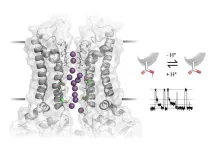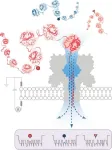Para-cresol is an aromatic compound with a strong horse stable-like odor. It contributes to the off-flavor of some foods, but it is also detectable as a characteristic odorant in whiskey and tobacco, as well as in the urine of various mammals. A research team led by the Leibniz Institute of Food Systems Biology at the Technical University of Munich has now discovered which odorant receptor humans use to perceive para-cresol.
Para-cresol (4-methylphenol) is formed during the microbial degradation of certain amino acids, but also during thermal degradation processes. As a result, it is present in various foods, where it can contribute to off-flavors in the aroma of white pepper, cocoa, rapeseed or olive oil, among others. In addition, para-cresol has long been known to attract insects such as mosquitoes, tsetse flies and horseflies, as well as horses and cattle.
A research team led by Dietmar Krautwurst from the Leibniz Institute in Freising has now succeeded for the first time in identifying the human odorant receptor for para-cresol using a cellular test system. "It was crucial that we had access to the pure substance available thanks to the excellent preparative and analytical work at our institute," reports first author Franziska Haag. "As we discovered, commercially available para-cresol is contaminated with an isomer that would have affected the results," she adds.
Over 600 human odorant receptors tested
The amounts of pure para-cresol obtained by high-performance liquid chromatography were sufficient to perform an extensive bidirectional receptor screening. The researchers tested which of more than 600 human odorant receptor variants responded to para-cresol. The screening revealed that the OR9Q2 receptor was the only one that responded to physiologically relevant concentrations of the substance. The team then investigated whether the receptor also responded to other odorants. To do this, they tested 176 substances known as key food odorants, which play an important role in shaping the aroma of food. Of these, only one other odorant, the structurally similar 4-ethylphenol, was able to significantly activate the receptor.
The research team then examined the concentration-response relationships between para-cresol and animal odorant receptors that are orthologs to the human receptor. The test results showed that the mouse receptor responded to para-cresol in a similar way to the human receptor. The cow receptor tested even showed significantly higher sensitivity to the substance. According to the team, the result is consistent with earlier findings that para-cresol acts as a pheromone in cows and exerts a sexual attraction on the animals even at very low concentrations.
The "para-cresol receptor" is highly selective
"The high selectivity of receptor OR9Q2 for para-cresol thus appears to be evolutionary conserved, emphasizing its dual importance: on the one hand, as a sensor of food and stimulant odors, and on the other hand, as a receptor for a signaling molecule that plays a role in the communication between animals of the same species. In addition, the receptor fills a gap in the recognition spectrum of the phylogenetically older human odorant receptor OR2W1, which detects a wide range of structurally different odorants, but not para-cresol," says principal investigator Dietmar Krautwurst. He adds, "In addition to these exciting findings, the new knowledge could be used in the future to develop biotechnologies that can be used to quickly and easily test the sensory quality of food along the entire value chain."
Publication: Haag, F., Frey, T., Hoffmann, S., Kreissl, J., Stein, J., Kobal, G., Hauner, H., and Krautwurst, D. (2023). The Multi-Faceted Food Odorant 4-Methylphenol Selectively Activates Evolutionary Conserved Receptor OR9Q2. Food Chem 426, 136492. 10.1016/j.foodchem.2023.136492. doi.org/10.1016/j.foodchem.2023.136492
Funding: The initial stages of this research were partially funded by a collaboration project with Altria Group Inc. in Richmond, VA, USA. Gerd Kobal was an employee of Altria during the initial phases.
More Information:
Humans possess approximately 400 different odorant receptor genes, which in turn encode over 600 different receptor variants in the nasal mucosa. These are responsible for the perception and discrimination of different odors. However, research is still needed to determine the exact number and function of all receptor variants. So far, it is only known for about 20 percent of the human odorant receptors which odorants they may detect best.
According to Dietmar Krautwurst, the cellular test system developed by the Leibniz researchers is unique in the world. He and his team have genetically modified the test cells so that they act like small biosensors for odorants. The researchers are able to determine exactly which odorant receptor variant is present on the surface of the test cells. In this way, the researchers can specifically investigate which receptor reacts how strongly to which odorant. The Leibniz Institute has extensive odorant and receptor collections that it uses for its research work.
Contacts:
Scientific Contacts:
PD Dr. Dietmar Krautwurst
Leibniz Institute for Food Systems Biology
at the Technical University of Munich (Leibniz-LSB@TUM)
Lise-Meitner-Str. 34
85354 Freising/Germany
Phone: +49 8161 71-2634
E-mail: d.krautwurst.leibniz-lsb(at)tum.de
Dr. Franziska Haag
Leibniz-LSB@TUM
Phone: +49 8161 71-2716
E-mail: f.haag.leibniz-lsb(at)tum.de
Press Contact at Leibniz-LSB@TUM:
Dr. Gisela Olias
Knowledge Transfer, Press and Public Relations
Phone: +49 8161 71-2980
E-mail: g.olias.leibniz-lsb(at)tum.de
www.leibniz-lsb.de
Information about the Institute:
The Leibniz Institute for Food Systems Biology at the Technical University of Munich (Leibniz-LSB@TUM) comprises a new, unique research profile at the interface of Food Chemistry & Biology, Chemosensors & Technology, and Bioinformatics & Machine Learning. As this profile has grown far beyond the previous core discipline of classical food chemistry, the institute spearheads the development of food systems biology. It aims to develop new approaches for the sustainable production of sufficient quantities of food whose biologically active effector molecule profiles are geared to health and nutritional needs, but also to the sensory preferences of consumers. To do so, the institute explores the complex networks of sensorically relevant effector molecules along the entire food production chain with a focus on making their effects systemically understandable and predictable in the long term.
The Leibniz-LSB@TUM is a member of the Leibniz Association (https://www.leibniz-gemeinschaft.de/en/), which connects 97 independent research institutions. Their orientation ranges from the natural sciences, engineering, and environmental sciences through economics, spatial and social sciences to the humanities. Leibniz Institutes devote themselves to social, economic, and ecological issues. They conduct knowledge-oriented and application-oriented research, also in the overlapping Leibniz research networks, are or maintain scientific infrastructures and offer research-based services. The Leibniz Association focuses on knowledge transfer, especially with the Leibniz Research Museums. It advises and informs politics, science, business, and the public. Leibniz institutions maintain close cooperation with universities - among others, in the form of the Leibniz Science Campuses, industry, and other partners in Germany and abroad. They are subject to a transparent and independent review process. Due to their national significance, the federal government and the federal states jointly fund the institutes of the Leibniz Association. The Leibniz Institutes employ around 21,000 people, including almost 12,000 scientists. The entire budget of all the institutes is more than two billion euros.
+++ Stay up to date via our Twitter channel twitter.com/LeibnizLSB +++
END






